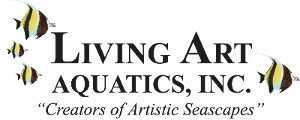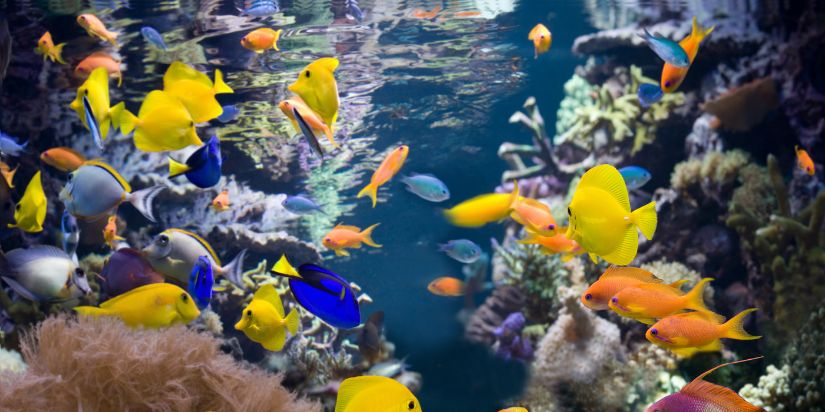There are many ways to interact with your tropical fish and enjoy your aquarium—watching them swim around, feeding them, teaching them tricks, etc. However, one of the most significant ways to get long-term satisfaction out of your aquarium is by breeding tropical fish.
Every variety of fish has its unique mating patterns, gestation periods, nutritional requirements and other considerations when producing offspring. Becoming a breeder is a big undertaking, and novices likely have a lot of questions. Below, we offer essential information on some of the main challenges tropical fish breeders face and advice on how to navigate them.
Creating a Hospitable Environment
Before you start coaxing your livestock to do the deed, you need to build an environment that will make them comfortable enough to do so. In nature, fish have evolved over countless generations to develop an instinctual knowledge of the perfect place and time for breeding. Your goal in building an optimal breeding environment is replicating that ideal environment the fish inhabits in nature.
Replicating the Natural Environment
To get started, you should research as many aspects of the species’ natural environment as possible. Learn the answers to questions like:
- How much driftwood, rocks and plants should I use?
- What’s the appropriate substrate?
- What’s the ideal temperature, pH and water hardness?
- What kind of light levels occur in my fish’s natural environment?
Also, consider how they lay their eggs. Do they lay them on flat and broad spots like leaves and smooth rocks (as cichlids do)? Or do their eggs fall and settle at the bottom, requiring a substrate of marbles to protect them from predators?
Fish have evolved to favor these specific conditions because they give them the best chance of good health and survival. With that in mind, a good breeding environment must also include extra care to ensure the water quality and other conditions are optimized for your tropical fish breeds.

Protecting Newborn Fish in Your Tropical Fish Tank
Newborn fish are more susceptible to variations in conditions like temperature, pH, and the presence of bacteria. Some tropical fish will eat their eggs or fry if they feel the environment isn’t good enough for them to survive. So be sure to keep up your proactive aquarium maintenance, use an adequate filter with filter media that has lots of surface area for water-cleansing bacteria, and consider temporarily removing the gravel from the bottom of the tank to remove rot and algae buildup.
Water changes can be performed weekly, but sometimes, it’s better not to disturb the water too much during breeding and egg-laying.
Remember that with all this planning to create a hospitable environment, it may be challenging to balance the needs of other fish that share the tank. Therefore, you might want to construct a separate spawning tank for your breeding activities.
Understanding Normal Fish Behavior
Strange behaviors from your tropical fish can prompt confusion and concern, both during and outside of regular mating seasons. If you want to be a successful tropical fish breeder, you must understand what “odd” behaviors may be expected and which should be cause for concern. You’ll want to perform intensive research on this and other topics before you begin trying to breed your fish.
Are Mating Rituals Driving Strange Behavior?
Some mating behaviors that fish exhibit might strike you as odd the first time you see them.
Indeed, many fish species have unique and unusual mating rituals. Among tropical fish, bonefish have been recently discovered to swirl like a tornado in their mating ceremonies. On the other hand, African electric fish play “duets” by exchanging bursts of electrical signals.
Among freshwater tropical fish, the male drummer fish produces grunting and rumbling that sounds like drumming to entice the female. Betta fish perform an intricate dance just before mating – watching these colorful tropical fish dance through the tank looks much like watching a stage performance!
Whatever species you have, they, too, may show seemingly odd behaviors that courtship rituals can explain.
But not all of them are so bizarre. Often, males build and defend nests as they enter mating seasons, even when chemically castrated. Pheromones released by females can excite them as well.
Even when no females are around, male fish are still driven to reproduce. These instinctive drives can result in more aggressive behavior than you’re used to seeing.
Why Would a Fish Play Dead?
Other fish behaviors can catch you off guard. Some are harmless, while others require you to step up your maintenance to prevent illness.
For example, some species may play dead to fool other fish, often targeting scavengers as a food source. The Central American cichlid is a perfect example.
In other species, though, this behavior might hint at a health issue. For example, goldfish floating to the top of the water upside down could be a sign of either a digestive problem or a case of dropsy. Fish swallowing too much air when swimming to the top for their food is a more common cause.
Luckily, there’s an easy remedy. Thaw some frozen peas, skin them, mash the insides into manageable bites, and feed the peas to the fish. This should clear up the digestive issue. You can then feed your tropical fish from the bottom or a few inches below the surface to manage the problem.
If none of this helps, you may want to treat your tropical fish for dropsy.
Is Water Quality or Disease the Culprit of Odd Behaviors?
Many fish naturally swim erratically during play or exercise. But this could also be the result of bad water quality. So, run some tests to see if that’s the case.
Poor water quality can cause lethargic, listless behavior. The symptoms are usually due to improper temperatures or overfeeding, however.
Gasping for air at the top of the tank can indicate poor water quality. In this case, test your water and consider an aquarium aerator.
Sitting at the bottom of the tank for a long time is normal for many species. Some spend all their time eating, sleeping and swimming near the bottom. Others seem inactive during the day because they’re nocturnal.

If odd behavior starts suddenly, however, it may be the result of a disease like a swim bladder infection. Water quality or diet issues usually cause infection.
Sometimes, you might notice fish showing more aggression. In this case, make sure your tank is large enough for the number of fish and has enough hiding space. If you want a lot of tropical fish to breed, you may need a huge aquarium.
These are other steps you can take to address fish aggression:
- Quarantine fish before adding them to the tank
- Change up the scenery to break up claims over territory
- Keep a variety of fish so they aren’t competing to fill the same role
Fish also may take on protective behaviors when adjusting to changes in the environment. For example, fish may hide when you first introduce a new fish to the aquarium.
If you change the tank’s layout or conditions, they may have the same reaction. This is normal, and most fish become less shy as they grow comfortable.
Encouraging Tropical Fish to Breed
Now that you’ve researched the right environment and common behaviors, you must go through the sometimes tricky process of getting your tropical fish to breed successfully.
First, you need to sex your fish and determine if you have a compatible set of fish, whether the species you’re working with mate in pairs or groups. Tropical fish can be sexually dimorphic or isomorphic. The dimorphic species are easy to distinguish because the males usually have significantly more color and finnage, whereas the isomorphic species are more challenging to differentiate. For this second type, you’ll need to look at the genital papilla visible during spawning times.
When selecting parent fish, look for these traits:
- Good colorings and markings
- Maturity and good health (fish that are too young or unhealthy will produce unhealthy fry)
- Compatibility (some species need first to be raised together for a long time)
- Similar strains or color forms
- Identical species
Matching fish with these characteristics will help produce healthy, attractive young.
After choosing the fish, you want to condition them by giving them highly nutritious food. For many species of tropical fish, this can take the form of well-balanced flakes. Others may need brine shrimp, flying insects or larvae.
Finally, start trying to trigger breeding. With many species (especially tropical fish from the Amazon River) removing some water and replacing it with some a couple of degrees cooler will simulate the rainy season, triggering their instincts to start breeding. Look up your species to learn what triggers or special circumstances they need.
Ensuring the Survival of Young
Don’t make the rookie mistake of overlooking what needs to happen after you’ve successfully gotten your fish to breed. Ensuring the survival of eggs or newly born fish fry is crucial.
The most critical step? Determining what spawning method your species uses.

Egg Layers
Egg layers can often be removed once they’ve laid and fertilized their eggs, as these species frequently have their eggs swept downstream in nature. If kept around, they may eat the eggs. While some care for their young for a short while after they hatch, most don’t, so you shouldn’t feel bad about separating them.
Livebearers
Livebearers are typically the easiest tropical fish to raise. Place the pregnant female in a separate tank, remove her after she gives birth, and feed the fry baby food or powdered flakes for 4-6 weeks until they’re large enough to be moved into the regular aquarium.
Mouth-Brooders
Mouth-brooders are more complicated. African cichlids are tropical fish that spawn in this way. The mothers are usually much smaller than the males and will get bullied by them if not given hiding spaces, which they can fit into, but the males cannot.
After spawning, the mothers will carry their eggs and babies in their mouths for up to two weeks. Move them to a separate tank during this time and help them feel at home.
Once they release the babies from their mouths, it’s time to separate them again. Feed the mothers a lot to help them recover (as they’ve not been eating much due to the young in their mouths). Give the young Spirulina and plenty of water changes to help them quickly grow to a decent size so they can all be integrated into the aquarium (or sold if that’s your aim).
Need More Advice About Tropical Fish?
If you follow the above guidance, you’ll hopefully come away with some healthy young. However, this is only a basic guide—to get the best results, you’ll want to research the specific conditions best for the species of tropical fish that you’re trying to raise. To help with that, you may wish to consult a professional.
Living Art Aquatics is always ready to answer your fish-related questions! We also create custom aquariums designed so your growing school of fish can thrive. Call us today for help bringing some new life into your aquarium—literally.
Editor’s Note: This blog was originally published in October of 2016 and was updated in March of 2024.





